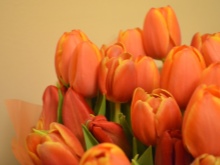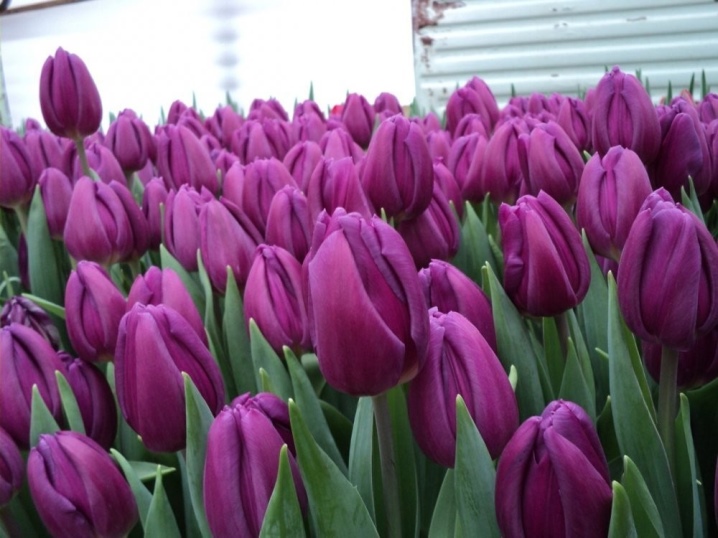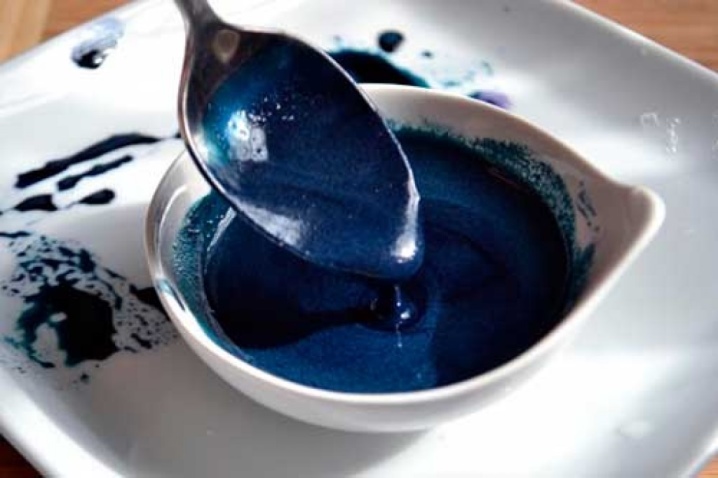All about blue and blue tulips

Tired of the long winter, we look forward to spring. We are waiting for the life-giving rays of the sun, melting snow and warm days. And the most important thing that marks the onset of the much-desired time of the year is the appearance of flowers.
Tulip is one of the most famous spring flowers. In nature, there are a huge number of its colors. But in flower shops, tulips of blue and blue shades are increasingly found. Are there really such in nature, or is it some cunning trick of sellers?

General information
Tulips are perennial bulbous plants, they belong to the lily family, the class of monocots. The birthplace of the flower is Persia (modern Iran). He came to Europe from Turkey. The characteristic features are the extremely rapid growth and development of the plant organism. For example, in areas with a rather harsh climate, the life cycle of a plant lasts only about three months.

Basically, varieties are divided by flowering time: early (simple and double), medium (Darwin hybrids and "Triumph"), late (simple, double, lily, parrot), in addition, wild or botanical ("Foster", "Kaufman" , "Craig").
Flowers can be classified according to the shape of the bud.
- Simple... A short tulip (about 30 cm) with a glass-shaped bud. If we consider simple tulips of late varieties, then they grow up to 75 cm in height and have a larger flower.

- Terry - short, about 25 cm, but the bud is large and, as a rule, has a bright color.

- Fringed... As the name suggests, the edges of the petals are bordered by a fringe, the stem is quite high - about 80 cm.

- Lily-colored... They are interesting in that they can have several flowers, and the bud itself looks like a lily.

- Parrot - also have an original shape and variegated color, really resemble parrot feathers.

Main varieties
Initially, wild tulips had a rather limited color palette. Mostly yellow, red and orange. The rest of the shades appeared due to selection.



There are a huge number of varieties and hybrids of this flower. And new varieties are registered every year. The palette of their colors is incredibly diverse. These are the usual yellow, red, white and orange shades, as well as exotic greens, blues, purples and even almost black. The color can be not only monochromatic, but also multicolored.


For several centuries, breeders from Holland have worked on breeding a blue or blue tulip, but in vain. And all due to the fact that in the chromosomes of these beautiful flowers there is no gene responsible for the blue pigmentation of the petals - delphinidin. However, the Dutch have managed to breed varieties of purple shades, in the light they look like blue or blue.

The following varieties can be considered as blue.
- Parrot tulips "Blue Parrot". This is an early variety, the stem grows up to 50 cm in height, the flower is large, up to 10 cm in diameter. The inflorescence of an unusual shape with wavy petals looks very impressive. It begins to bloom in May. At first, the bud is green, but as it opens, it changes color from purple to blue with a silver tint.

- Blue Diamond and Blue Spectacle. Late double varieties. Reach a height of 50-60 cm, the diameter of the flower is about 12 cm. Luxurious double inflorescences with slightly wavy petals have an unusual color - lilac with a blue tint.

- "Triumph Blue Beauty". This species is characterized by a goblet flower.This tulip is a tall species.

- Lily-colored "Purple Dream". Tall variety. Blooms in the second half of May. The flower resembles a lily - large, with pointed edges slightly bent outward. The bud has a pale lilac color.

- Blue Heron. Representative of fringed varieties. Up to 50 cm high, with a large goblet bud (7-9 cm), with a thick long fringe along the edges of the petals. The flower is painted in a delicate blue-violet color.

- The "Cummins" variety also belongs to the fringed ones. A distinctive feature is an expressive white fringe on the petals and a slightly unusual shape of the bud.

- Tulip "Barracuda". An incredibly delicate flower of a purple hue, despite the somewhat predatory name of the species. Refers to early flowering varieties.

- Another representative of double tulips is Lilac Perfection. A very unusual shape of the buds, completely unlike the classic "glasses" of a tulip.

- Canova. Fringed tulip of pale lilac color with light strokes.

So, don't be fooled if a seller or ad image promises you tulips in blue or light blue. Most likely, the color of the bud will be in the range from pale lilac to dark purple.

Features of growing and care
Tulips cannot be called unpretentious plants. They grow and bloom only under certain climatic conditions. They require good lighting and a suitable soil composition.
These bulbous are very light-requiring, they only need well-lit places. Late varieties of tulips, for example, "Blue Diamond" can, of course, tolerate a little shade, it is permissible to plant them near trees or shrubs, if their leaves bloom late so that tulips do not experience a lack of light during flowering.

If we talk about the soil, then tulips prefer neutral or slightly alkaline, well-cultivated soils. And for varieties like Cummins, wind protection should be taken care of.

How to paint?
As we have already found out, the breeders have not been able to breed tulips of a pure blue or light blue hue. However, if you really want to give the flowers unusual, unusual shades, there are several ways.
On the Internet, users share tips on how to get the desired shade.

Fresh cut flowers in white or cream shades are best for coloring. The most common and affordable way is with food coloring. To do this, you need to purchase a dye of the desired color. Add it to a vase of water. It should be remembered that the more dye you add, the richer the color will be and vice versa.

Further, excess leaves are removed from the stem of the prepared plant, and its tip is cut off with scissors at an angle of 45 degrees. Place the flowers in the water and wait. Painting can take up to 24 hours. After the petals are colored, you need to carefully remove the flowers from the solution, cut the stems again, rinse under running water and put in a vase.

You can paint the buds of a plant in a blue tone if you water the soil around it with a solution of cobalt acid. Another method of painting involves the purchase of a special floristic paint. The essence of the method is to paint the flower petals outside with paint, so you can use any flowers, not just white or cream... In order for the paint to completely color all the petals, it is necessary to select the completely blossoming flowers.

The dye is poured into any convenient container. Holding the plant by the tip of the stem, gently dip the bud into the dye and hold for a few seconds. Then take out and rinse with clean water. If paint splashes on your clothing or work surface, the stain will be difficult to remove. Place the painted flowers in a vase of water and let the buds dry completely.

The story about blue tulips is in the next video.







































































































The comment was sent successfully.